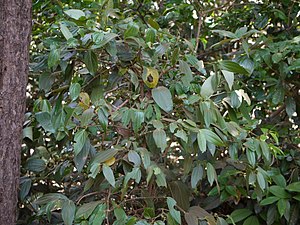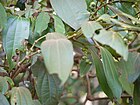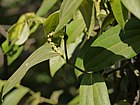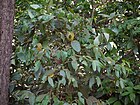Note: This is a project under development. The articles on this wiki are just being initiated and broadly incomplete. You can Help creating new pages.
Piper nigrum - Marica, Black pepper
Black pepper (Piper nigrum) is a flowering vine in the family Piperaceae, cultivated for its fruit, which is usually dried and used as a spice and seasoning, known as a peppercorn. When fresh and fully mature, it is about 5 mm (0.20 in) in diameter and dark red, and contains a single seed, like all drupes. Black pepper is native to Kerala in Southwestern India and is extensively cultivated there and elsewhere in tropical regions. Vietnam is the world's largest producer and exporter of pepper, producing 34% of the world's P. nigrum crop as of 2013.
Contents
- 1 Uses
- 2 Parts Used
- 3 Chemical Composition
- 4 Common names
- 5 Properties
- 6 Habit
- 7 Identification
- 8 List of Ayurvedic medicine in which the herb is used
- 9 Where to get the saplings
- 10 Mode of Propagation
- 11 How to plant/cultivate
- 12 Commonly seen growing in areas
- 13 Photo Gallery
- 14 References
- 15 External Links
Uses
Improves Digestion, Vitiligo, Skin disease, Peptic Ulcers, Asthma, Indigestion.
Parts Used
Chemical Composition
It contains globulol, α-pinene, β-caryophyllene and α-terpinene.[1]
Common names
| Language | Common name |
|---|---|
| Kannada | Eddemunchi, eddemunci, kaalu menasu, karee menasu |
| Hindi | chocamirch, filfilgird |
| Malayalam | cattu-molagoi, kolakam, kuru-milagu, kuru-mulaka |
| Tamil | aguttam, akuttam, alar2, alarkay, alarkaycceti, alarmancal, alivaliyanmani |
| Telugu | maarichamu, maricamu |
| Marathi | NA |
| Gujarathi | NA |
| Punjabi | NA |
| Kashmiri | NA |
| Sanskrit | cavyam, dhanwantari, dharmapattana |
| English | Black pepper, Madagascar pepper |
Properties
Reference:Dravya - Substance, Rasa - Taste, Guna - Qualities, Veerya - Potency, Vipaka - Post-digesion effect, Karma - Pharmacological activity, Prabhava - Therepeutics.
Dravya
Rasa
Guna
Veerya
Vipaka
Karma
Prabhava
Habit
Identification
Leaf
| Kind | Shape | Feature |
|---|---|---|
| alternative | Oblong | Leaf Arrangement is Alternate-spiral |
Flower
| Type | Size | Color and composition | Stamen | More information |
|---|---|---|---|---|
| Unisexual | 2-4cm long | White, yellow | The small flowers are in dense slender spikes of about 50 blossoms each |
Fruit
| Type | Size | Mass | Appearance | Seeds | More information |
|---|---|---|---|---|---|
| oblong pod | 5 mm in diameter | seeds upto 1 | Fruiting throughout the year | {{{6}}} |
Other features
List of Ayurvedic medicine in which the herb is used
Where to get the saplings
Mode of Propagation
How to plant/cultivate
A plant of the hot and humid lowland tropics, where it grows best at elevations up to 500 metres, but can be grown up to 2,000 metres. It grows best in areas where annual daytime temperatures are within the range 22 - 35°c, but can tolerate 10 - 40 °c Cuttings - very easy and the most common commercial method of propagation[4]
Commonly seen growing in areas
Trophical region, At moist regions, At hot regions.
Photo Gallery
References
External Links
- Ayurvedic Herbs known to be helpful to treat Improves Digestion
- Ayurvedic Herbs known to be helpful to treat Vitiligo
- Ayurvedic Herbs known to be helpful to treat Skin disease
- Ayurvedic Herbs known to be helpful to treat Peptic Ulcers
- Ayurvedic Herbs known to be helpful to treat Asthma
- Ayurvedic Herbs known to be helpful to treat Indigestion
- Herbs with Seeds used in medicine
- Herbs with leaves used in medicine
- Herbs with common name in Kannada
- Herbs with common name in Hindi
- Herbs with common name in Malayalam
- Herbs with common name in Tamil
- Herbs with common name in Telugu
- Herbs with common name in Sanskrit
- Herbs with common name in English
- Habit - Climber
- Index of Plants which can be propagated by Cuttings
- Index of Plants which can be propagated by Seeds
- Herbs that are commonly seen in the region of Trophical region
- Herbs that are commonly seen in the region of At moist regions
- Herbs that are commonly seen in the region of At hot regions
- Herbs
- Piperaceae










